The Benefits of Receiver Clock Modelling in Satellite Timing
Abstract
1. Introduction
2. The Feasibility of a Two-State Clock Model with Three Kinds of Noise for Use in a PPP Kalman Filter Estimation
3. Analysis of Position and Troposphere with Clock Modelling
3.1. Data Description
3.2. The Feasibility of Clock Modelling
3.3. The Analysis of Correlation Coefficient
3.4. Analysis of Position Performance
3.5. The Analysis of Troposphere Performance
4. The Evaluation of Timing Performance
5. Conclusions
- (1)
- Whatever the kinematic or static scheme used, the timing stability has been remarkably enhanced at all the averaging time, especially, it is effective for the short term stability. Furtherly, the stability improvement has some relation with the clock type and the processing strategy. As ‘good’ clock as concerned, the frequency stability improvement of kinematic scheme is bigger than that of the static scheme. For the ‘bad’ clock, the stability improvement of kinematic scheme is smaller than that of the static scheme.
- (2)
- When the clock modeling is applied, the correlation between the height component and the receiver clock offset has been degraded. The decorrelation extent of kinematic solution is more obvious than that of static scheme.
- (3)
- The application of clock modeling is related to the sampling and the clock type. The good clock is preferred for clock modeling. When the sampling goes longer, the model is possible to useless.
Author Contributions
Funding
Institutional Review Board Statement
Informed Consent Statement
Data Availability Statement
Acknowledgments
Conflicts of Interest
References
- Boccia, L.; Amendola, G.; Gao, S.; Chen, C.-C. Quantitative evaluation of multipath rejection capabilities of GNSS antennas. GPS Solut. 2013, 18, 199–208. [Google Scholar] [CrossRef]
- Leute, J. Characterization and evaluation of GPS PPP techniques for optical clock comparisons. Ph.D. Thesis, Leibniz Universität Hannover, Hanover, Lower Saxony, Germany, 2018. [Google Scholar]
- Defraigne, P.; Aerts, W.; Pottiaux, E. Monitoring of UTC(k)’s using PPP and IGS real-time products. GPS Solut. 2014, 19, 165–172. [Google Scholar] [CrossRef]
- Petit, G.; Kanj, A.; Loyer, S.; Delporte, J.; FMercier, F. Perosanz, 1 × 10−16 frequency transfer by GPS PPP with integer ambiguity resolution. Metrologia 2015, 52, 301–309. [Google Scholar] [CrossRef]
- Guang, W.; Dong, S.; Wu, W.; Zhang, J.; Yuan, H.; Zhang, S. Progress of BeiDou time transfer at NTSC. Metrologia 2018, 55, 175–187. [Google Scholar] [CrossRef]
- Zhang, P.; Tu, R.; Gao, Y.; Liu, N.; Zhang, R. Improving Galileo’s Carrier-Phase Time Transfer Based on Prior Constraint Information. J. Navig. 2018, 72, 121–139. [Google Scholar] [CrossRef]
- Tu, R.; Zhang, P.; Zhang, R.; Liu, J.; Lu, X. Modeling and Assessment of Precise Time Transfer by Using BeiDou Navigation Satellite System Triple-Frequency Signals. Sensors 2018, 18, 1017. [Google Scholar] [CrossRef]
- Shi, C.; Guo, S.; Gu, S.; Yang, X.; Gong, X.; Deng, Z.; Ge, M.; Schuh, H. Multi-GNSS satellite clock estimation constrained with oscillator noise model in the existence of data discontinuity. J. Geod. 2018, 93, 515–528. [Google Scholar] [CrossRef]
- Masoumi, S.; McClusky, S.; Koulali, A.; Tregoning, P. A directional model of tropospheric horizontal gradients in Global Positioning System and its application for particular weather scenarios. J. Geophys. Res. Atmos. 2017, 122, 4401–4425. [Google Scholar] [CrossRef]
- Krawinkel, T.; Schön, S. Benefits of receiver clock modeling in code-based GNSS navigation. GPS Solut. 2015, 20, 687–701. [Google Scholar] [CrossRef]
- Wang, K.; Rothacher, M. Stochastic modeling of high-stability ground clocks in GPS analysis. J. Geod. 2013, 87, 427–437. [Google Scholar] [CrossRef]
- Ge, Y.; Zhou, F.; Liu, T.; Qin, W.; Wang, S.; Yang, X. Enhancing real-time precise point positioning time and frequency transfer with receiver clock modeling. GPS Solut. 2018, 23, 20. [Google Scholar] [CrossRef]
- Ge, Y.; Dai, P.; Qin, W.; Yang, X.; Zhou, F.; Wang, S.; Zhao, X. Performance of Multi-GNSS Precise Point Positioning Time and Frequency Transfer with Clock Modeling. Remote Sens. 2019, 11, 347. [Google Scholar] [CrossRef]
- Lyu, D.; Zeng, F.; Ouyang, X.; Zhang, H. Real-time clock comparison and monitoring with multi-GNSS precise point positioning: GPS, GLONASS and Galileo. Adv. Space Res. 2020, 65, 560–571. [Google Scholar] [CrossRef]
- Wang, K.; Rothacher, M. Satellite-Clock Modeling in Single-Frequency PPP-RTK Processing. J. Surv. Eng. 2018, 144, 04018003. [Google Scholar] [CrossRef]
- Weinbach, U.; Schön, S. Improved GPS-based coseismic displacement monitoring using high-precision oscillators. Geophys. Res. Lett. 2015, 42, 3773–3779. [Google Scholar] [CrossRef]
- Cheng, W.; Nie, G. An adaptive oscillator noise analysis using factor analysis. Metrologia 2013, 50, 586–595. [Google Scholar] [CrossRef]
- Huang, G.; Cui, B.; Zhang, Q.; Fu, W.; Li, P. An Improved Predicted Model for BDS Ultra-Rapid Satellite Clock Offsets. Remote Sens. 2018, 10, 60. [Google Scholar] [CrossRef]
- Koch, D.; Rothacher, M. Satellite clock modeling for kinematic determination. In Proceedings of the 20th EGU General Assembly, EGU 2018 Conference, Vienna, Austria, 4–13 April 2018; p. 14182. [Google Scholar]
- Weinbach, U.; Schön, S. Improved GRACE kinematic orbit determination using GPS receiver clock modeling. GPS Solut. 2012, 17, 511–520. [Google Scholar] [CrossRef]
- Allan, D.W.; Barnes, J.A. A modified “Allan variance” with increased oscillator characterization ability. In Proceedings of the Thirty Fifth Annual Frequency Control Symposium 1981, Philadelphia, PA, USA, 27–29 May 1981. [Google Scholar]
- Petit, G.; Luzum, B. IERS Conventions (2010). Bureau International des Poids et Mesures Sevres (France). (2010) (No. IERS-TN-36).
- Wu, J.T.; Wu, S.C.; Hajj, G.A.; Bertiger, W.I.; Lichten, S.M. Effects of antenna orienation on GPS carrier phase. Manuscr. Geod. 1992, 18, 91–98. [Google Scholar]
- Mohammed, J.; Moore, T.; Hill, C.; Bingley, R.M. Alternative Strategy for Estimating Zenith Tropospheric Delay from Precise Point Positioning. Atmos. Meas. Tech. Discuss. 2017, 100, 1–24. [Google Scholar]
- Petit, G.; Leute, J.; Loyer, S.; Perosanz, F. Sub 10–16 frequency transfer with IPPP: Recent results. In Proceedings of the 2017 Joint Conference of the European Frequency and Time Forum and IEEE International Frequency Control Symposium (EFTF/IFCS), Besancon, France, 9–13 July 2017; pp. 784–787. [Google Scholar]
- Chen, X.; Lu, C.; Guo, B.; Guo, F.; Ge, M.; Li, X.; Schuh, H. GPS/GLONASS Combined Precise Point Positioning with the Modeling of Highly-stable Receiver Clock in the Application of Monitoring Active Seismic Deformation. J. Geophys. Res. Solid Earth 2018, 123, 4025–4040. [Google Scholar] [CrossRef]
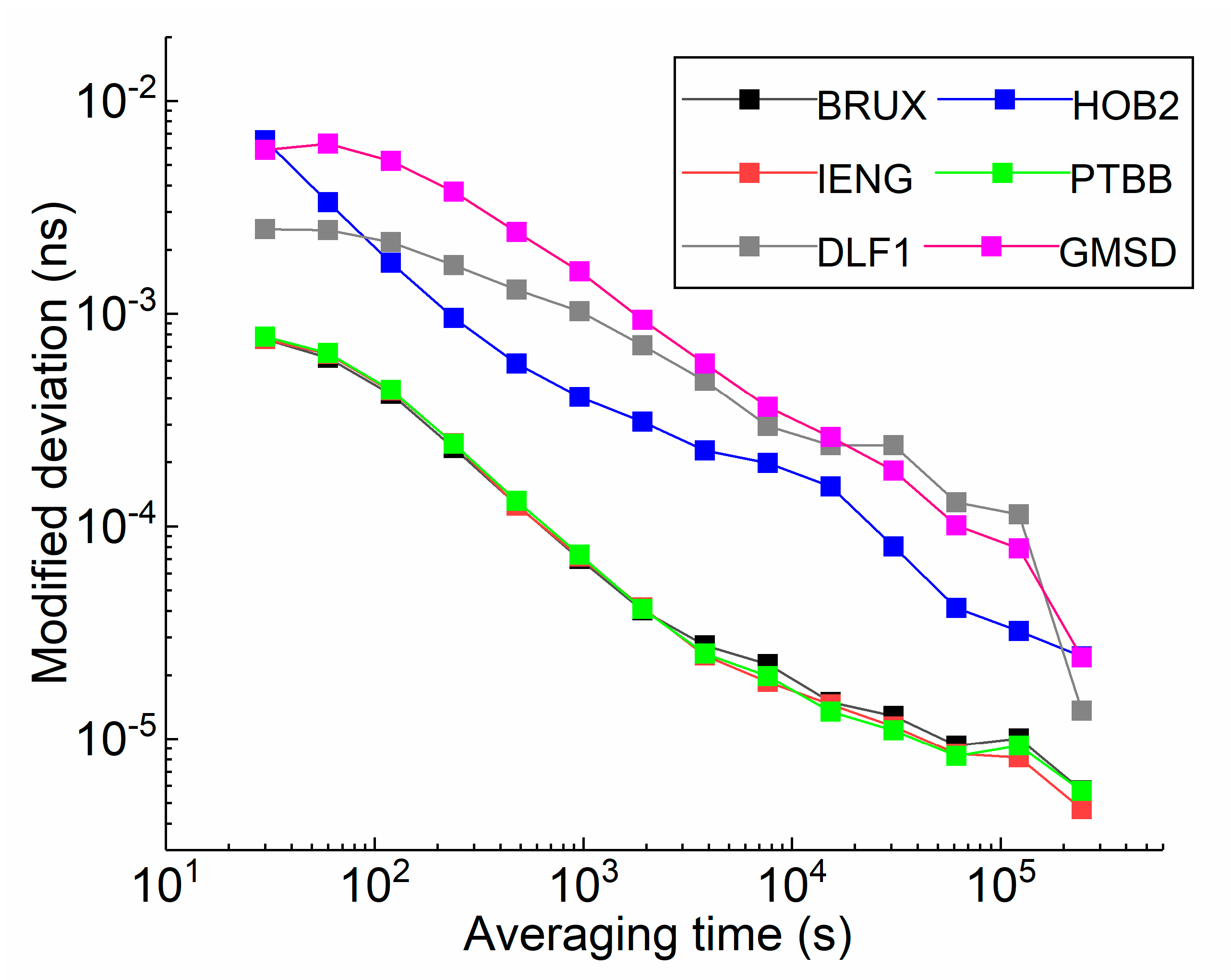
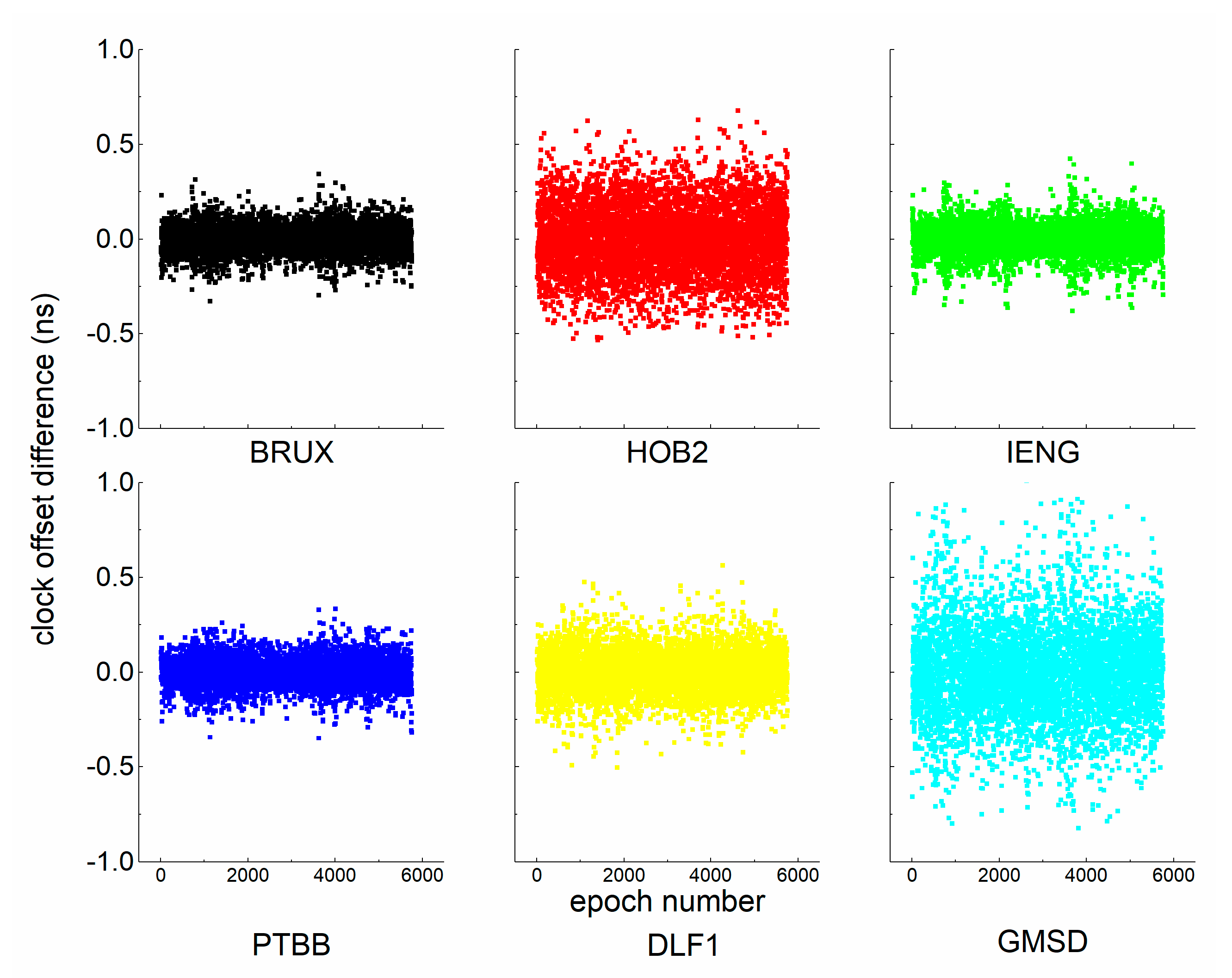
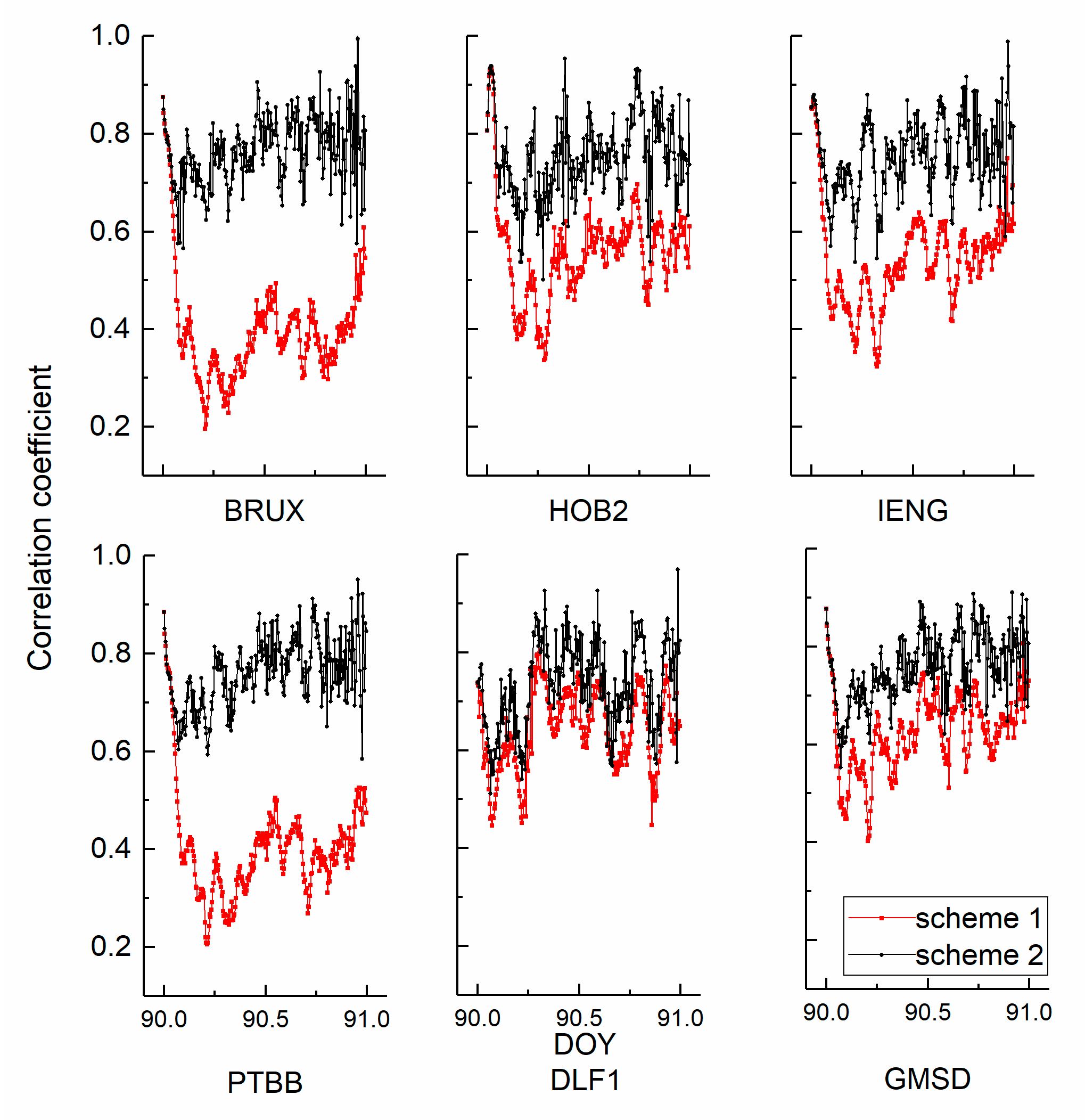
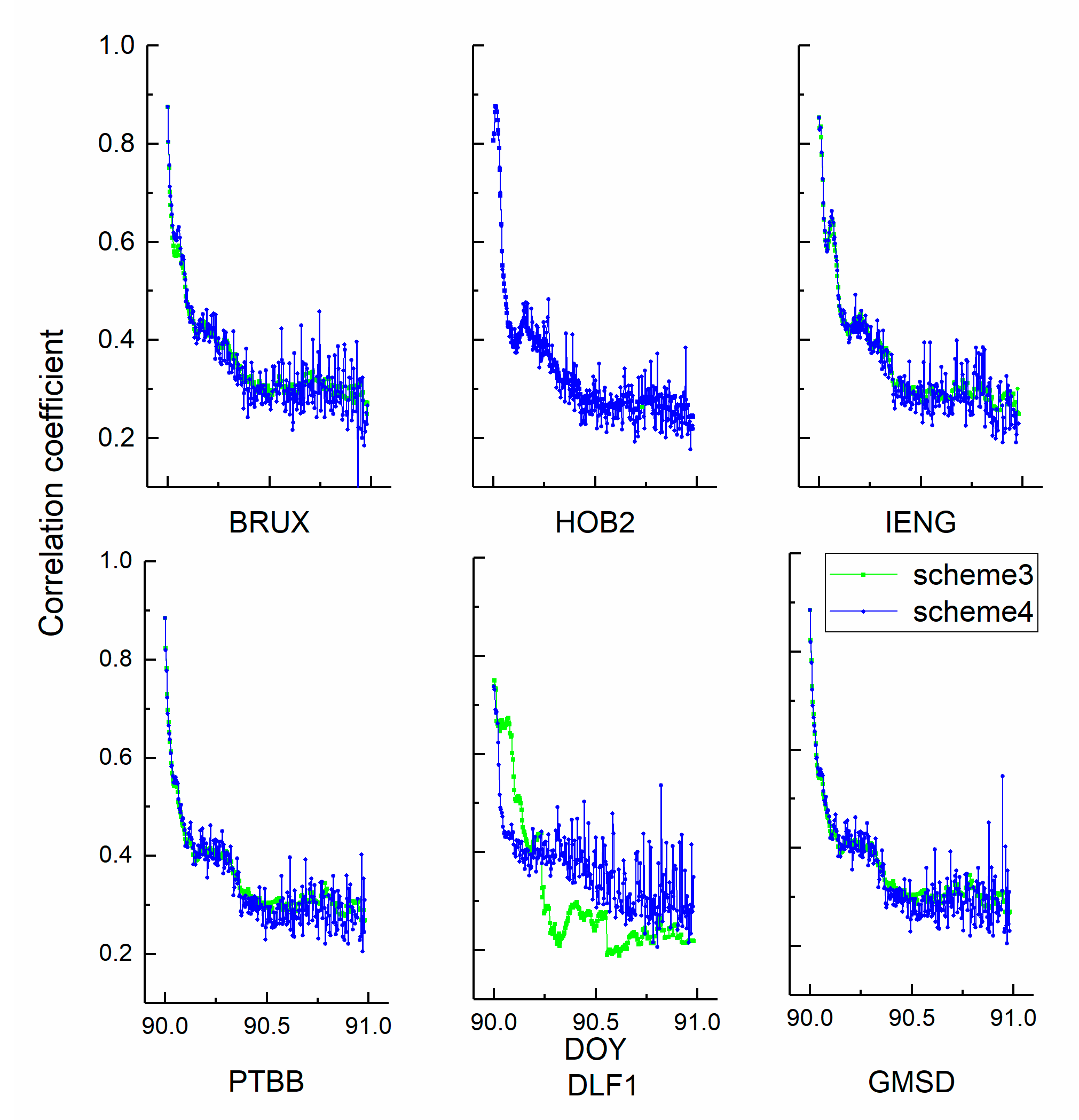
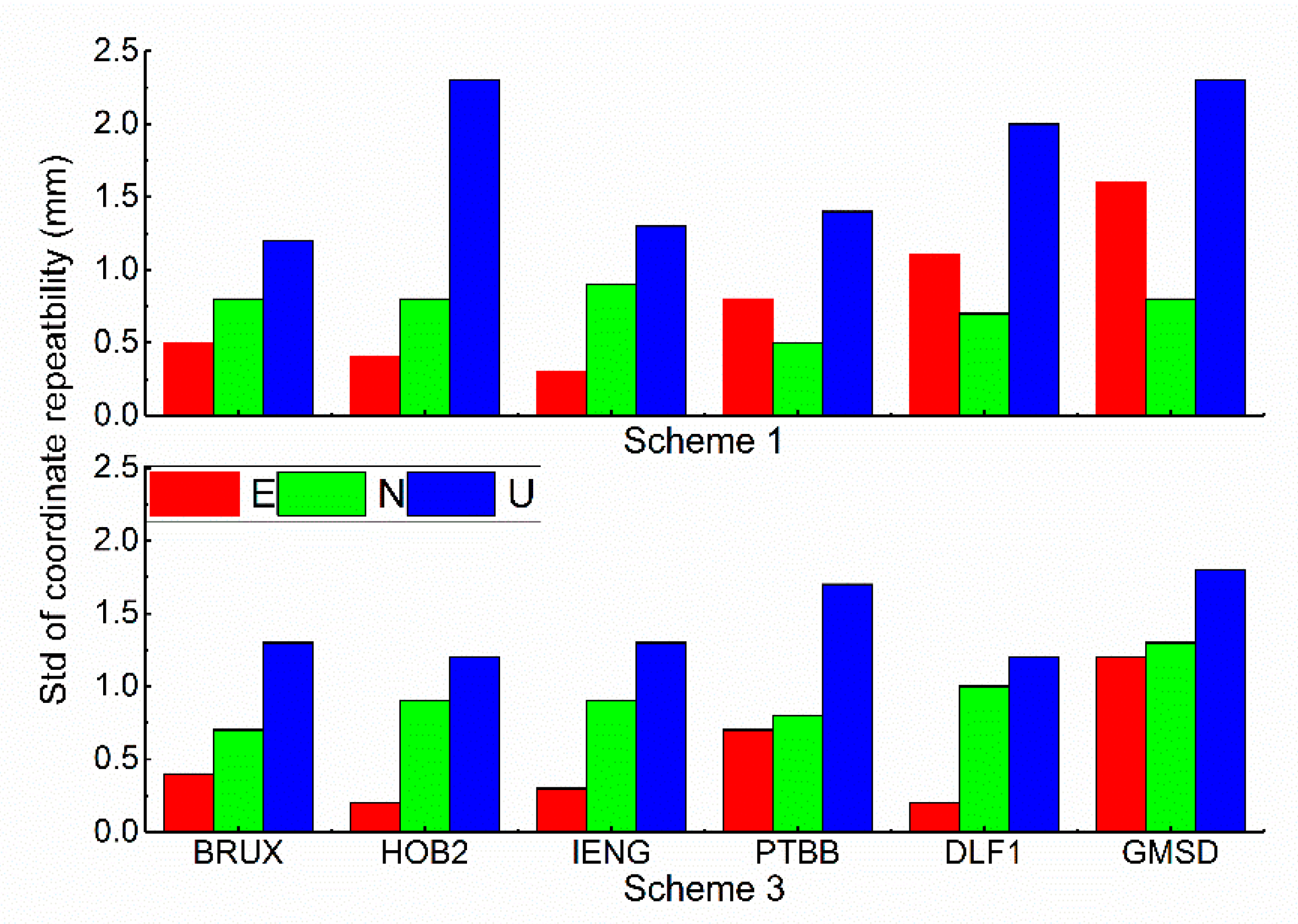
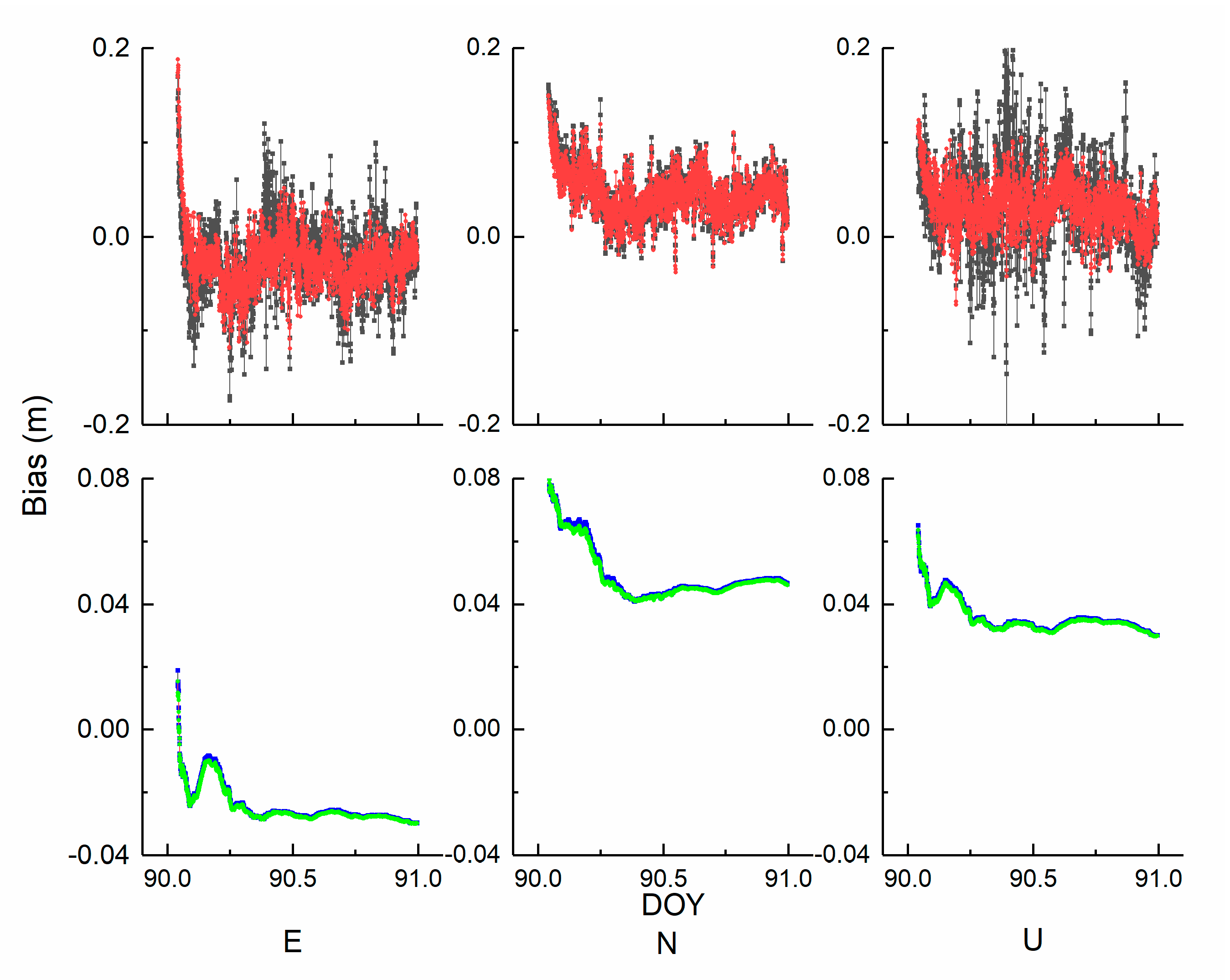

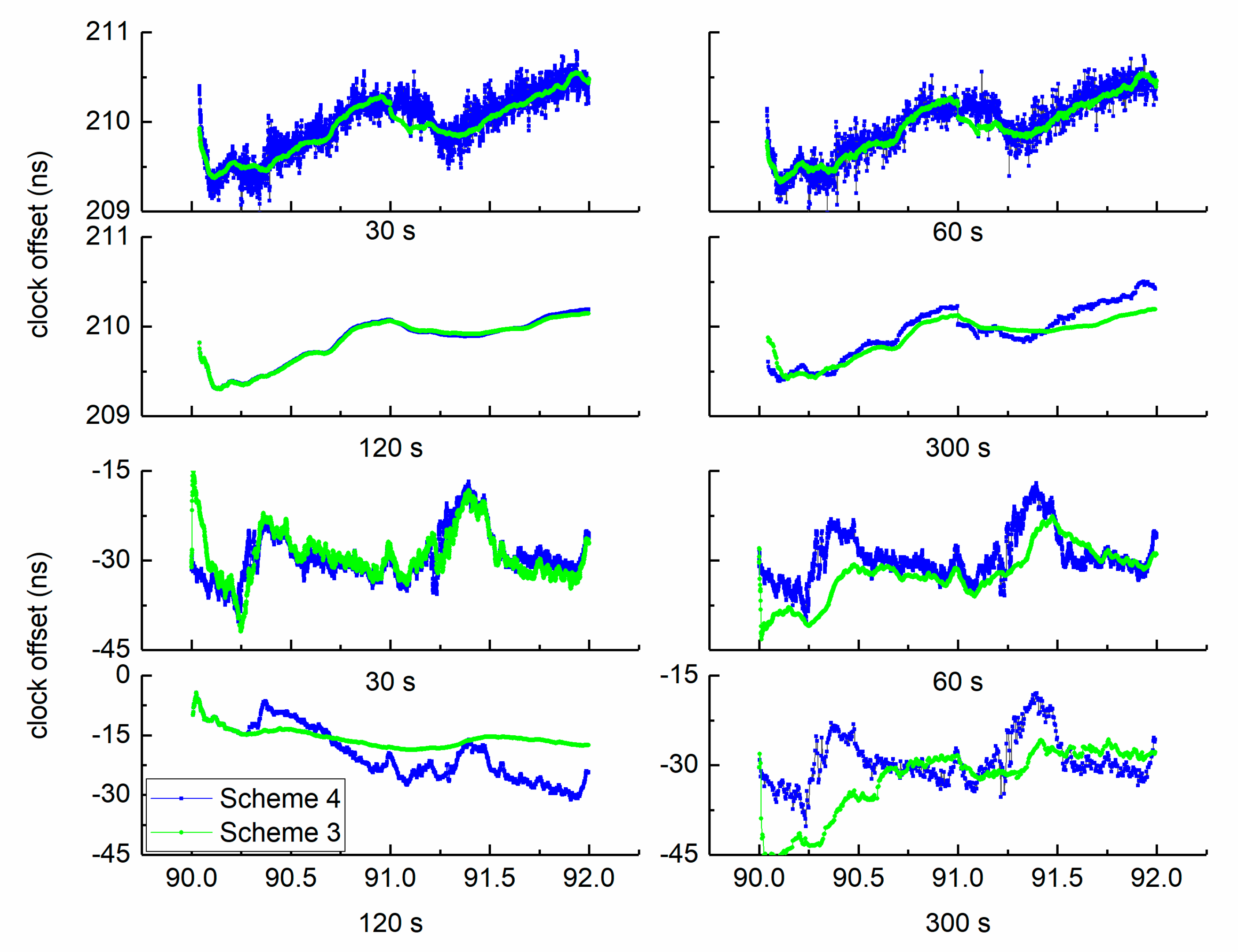

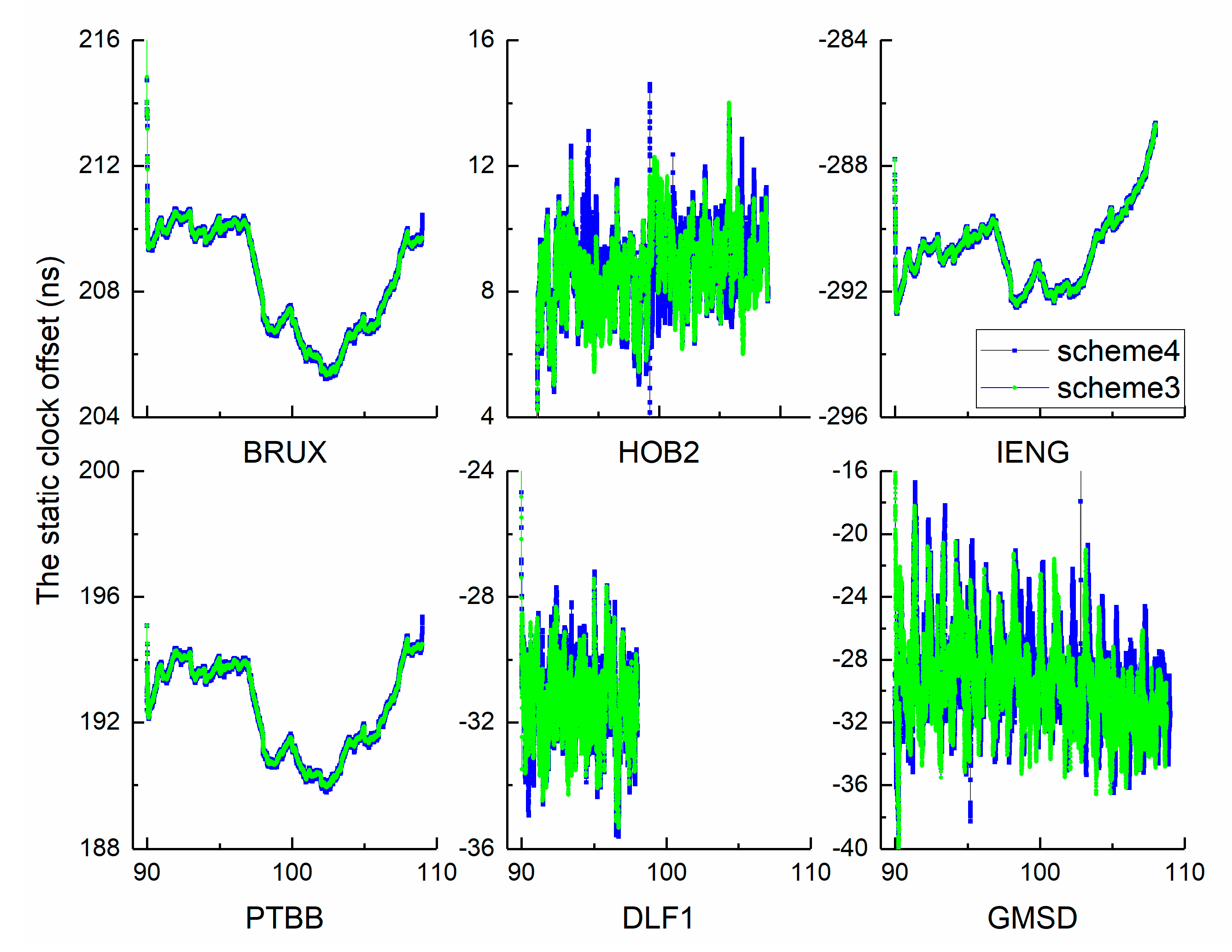
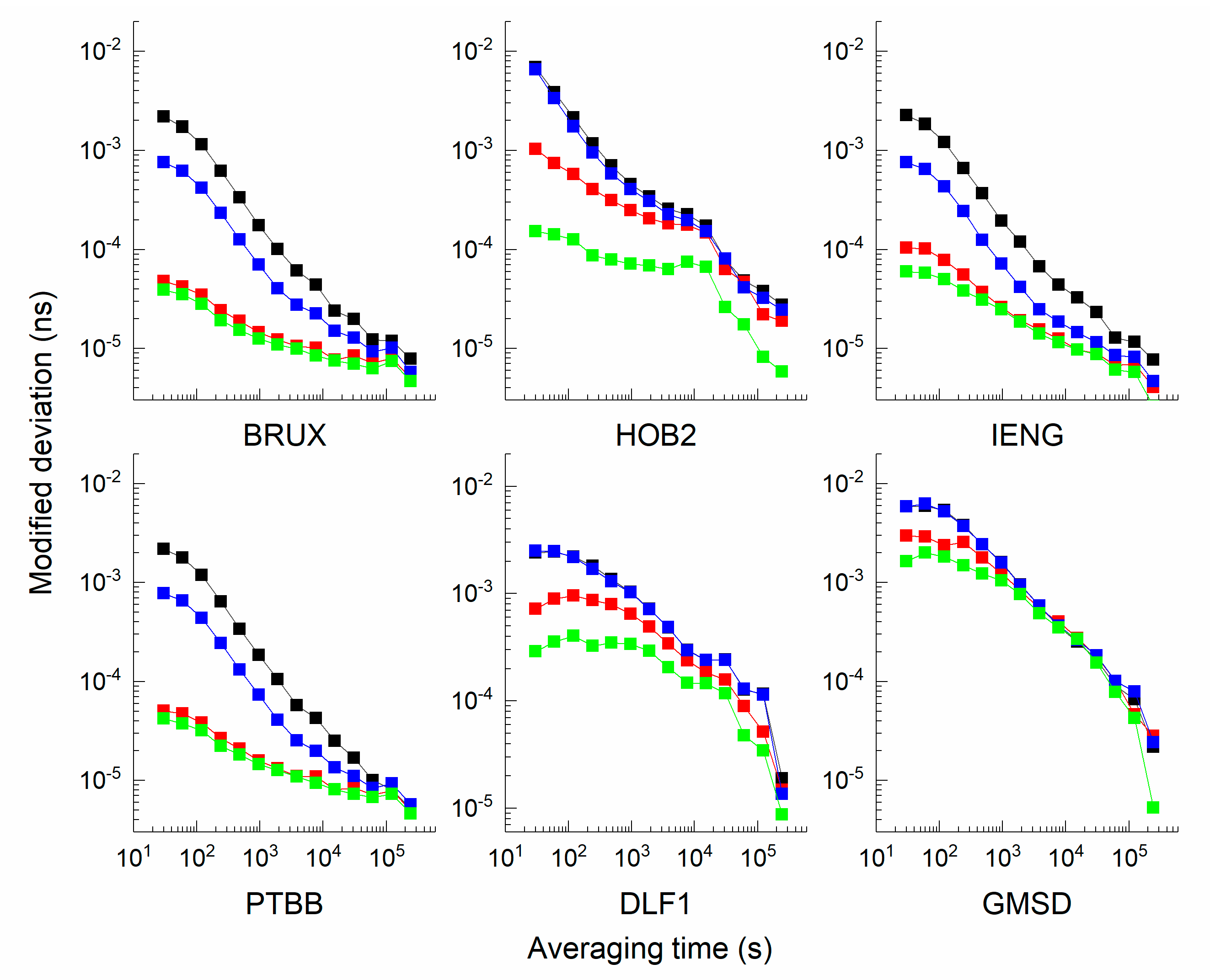
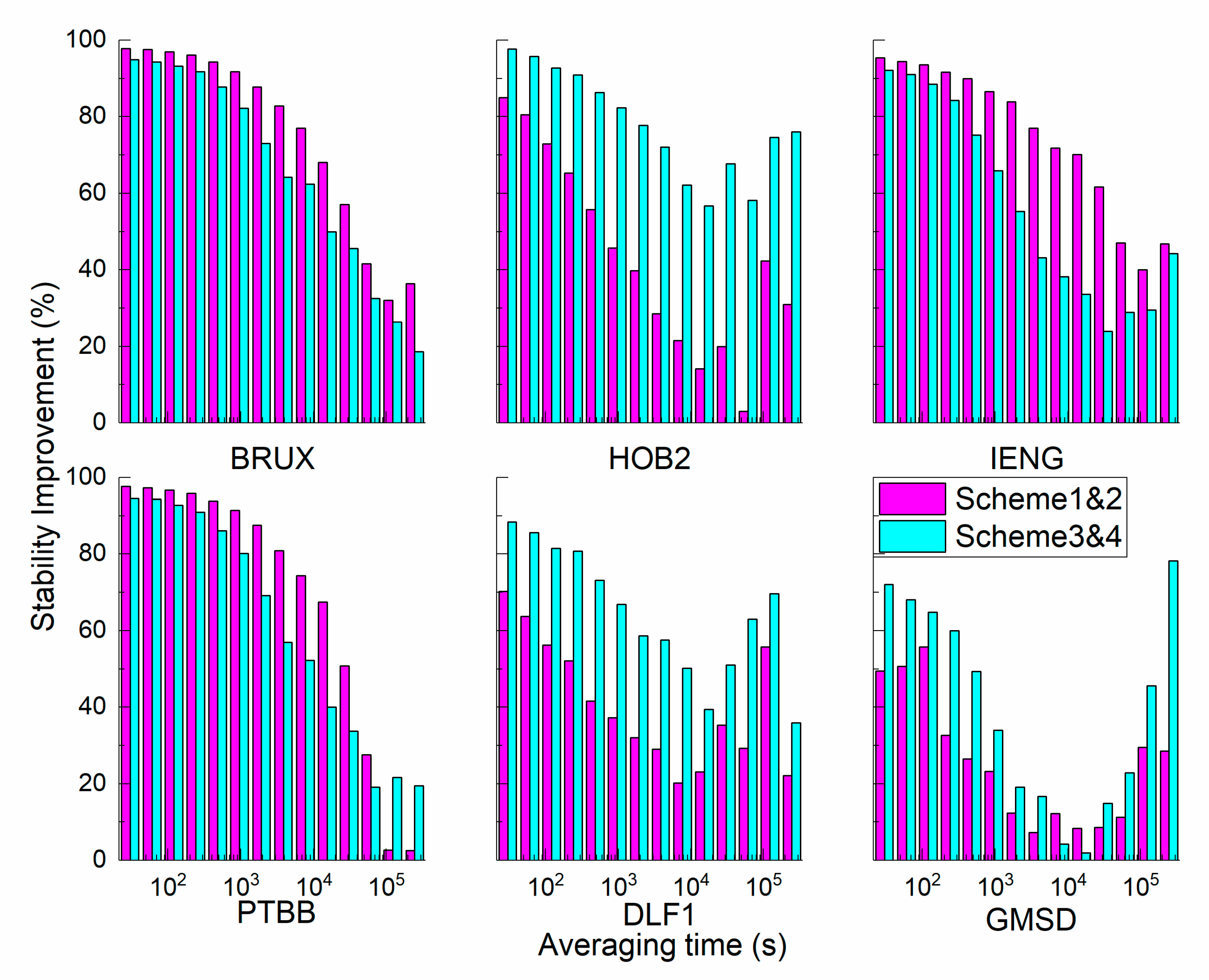
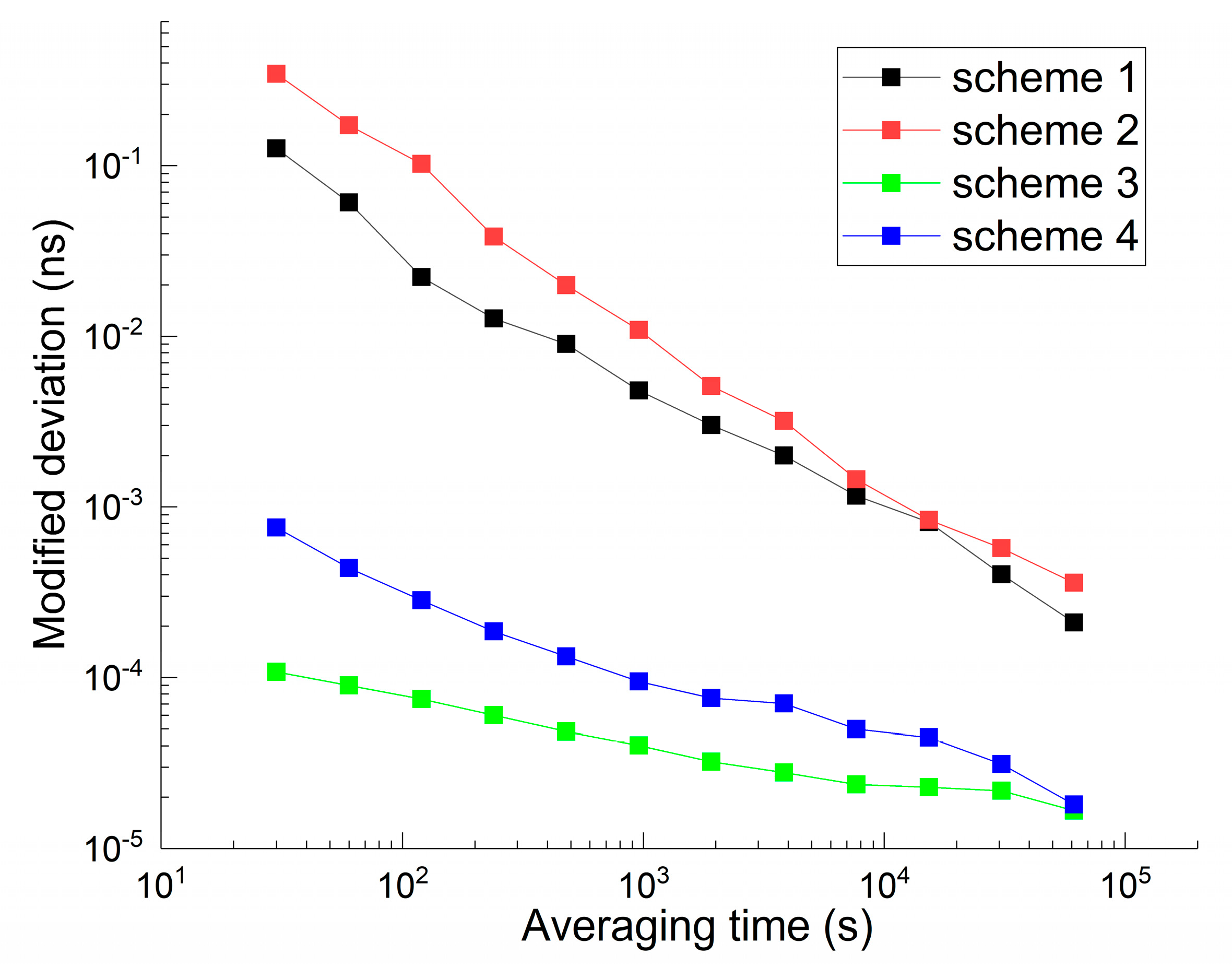
| Station Name | Location | Receiver Type | Antenna Type | External Clock |
|---|---|---|---|---|
| BRUX | Belgium | SEPT POLARX5TR | JAVRINGANT_DM | Active H-MASER |
| HOB2 | Austria | SEPT POLARX5 | AOAD/M_T | H-MASER |
| IENG | Italy | SEPT POLARX4TR | SEPCHOKE_C | H-MASER |
| PTBB | Germany | CETC-54-GMR-4016 | LEIAR25.R4 | H-MASER |
| DLF1 | The Netherlands | TRIMBLE NETR9 | LEIAR25.R4 | CESIUM |
| GMSD | Japan | TRIMBLE NETR9 | TRM59800 | CESIUM |
| Item | Strategies |
|---|---|
| Estimator | Kalman filter |
| Relativistic effect | IERS conventions 2010 [22] |
| Sagnac effect | IERS conventions 2010 |
| Phase wind-up | Model corrected to wu [23] |
| Ionospheric delay | IF linear combination |
| Tide displacements | IERS conventions 2010 |
| Tropospheric delay | estimated as a continuous piecewise linear function (2 h parameter spacing) [24] |
| Receiver clock offset | Estimated via the white noise process [25] |
| Ambiguity | Estimated as a constant |
| Station coordinate | Static solution: estimated as a constant |
| Simulated kinematic solution: estimated as white noise | |
| Solution | Scheme 1 Kinematic mode with clock model |
| Scheme 2 Kinematic mode with white noise | |
| Scheme 3 Static mode with clock model | |
| Scheme 4 Static mode with white noise |
| IGS Station | h-2 | h-1 | h-0 |
|---|---|---|---|
| BRUX | 2.52 e-29 | −1.05 e-25 | 8.22 e-23 |
| HOB2 | −2.13 e-29 | 1.52 e-25 | 1.05 e-23 |
| IENG | 1.76 e-29 | −7.89e-26 | 6.21 e-23 |
| PTBB | 2.40 e-29 | −1.00 e-25 | 7.63 e-23 |
| DLF1 | −1.58 e-27 | 3.33 e-24 | 3.83 e-22 |
| GMSD | 1.13 e-27 | −7.37 e-24 | 1.38 e-20 |
| Station | BRUX | HOB2 | IENG | PTBB | DLF1 | GMSD | |||||||
|---|---|---|---|---|---|---|---|---|---|---|---|---|---|
| Averaging Time (s) | sta | kin | sta | kin | sta | kin | sta | kin | sta | kin | sta | kin | |
| 100 | 96.98 | 93.27 | 72.96 | 92.74 | 93.58 | 88.47 | 96.76 | 92.68 | 56.26 | 81.46 | 55.76 | 64.80 | |
| 1000 | 91.77 | 82.17 | 45.65 | 82.33 | 86.58 | 65.86 | 91.40 | 80.16 | 37.23 | 66.89 | 23.22 | 33.92 | |
| 10,000 | 76.96 | 62.39 | 21.46 | 62.14 | 71.80 | 38.19 | 74.32 | 52.26 | 20.24 | 50.16 | 12.24 | 4.22 | |
| 86,400 | 41.58 | 32.50 | 2.97 | 58.14 | 47.02 | 28.94 | 27.62 | 19.09 | 29.27 | 63.05 | 11.27 | 22.82 | |
Publisher’s Note: MDPI stays neutral with regard to jurisdictional claims in published maps and institutional affiliations. |
© 2021 by the authors. Licensee MDPI, Basel, Switzerland. This article is an open access article distributed under the terms and conditions of the Creative Commons Attribution (CC BY) license (http://creativecommons.org/licenses/by/4.0/).
Share and Cite
Qin, W.; Wang, X.; Su, H.; Zhang, Z.; Li, X.; Yang, X. The Benefits of Receiver Clock Modelling in Satellite Timing. Sensors 2021, 21, 466. https://doi.org/10.3390/s21020466
Qin W, Wang X, Su H, Zhang Z, Li X, Yang X. The Benefits of Receiver Clock Modelling in Satellite Timing. Sensors. 2021; 21(2):466. https://doi.org/10.3390/s21020466
Chicago/Turabian StyleQin, Weijin, Xiao Wang, Hang Su, Zhe Zhang, Xiao Li, and Xuhai Yang. 2021. "The Benefits of Receiver Clock Modelling in Satellite Timing" Sensors 21, no. 2: 466. https://doi.org/10.3390/s21020466
APA StyleQin, W., Wang, X., Su, H., Zhang, Z., Li, X., & Yang, X. (2021). The Benefits of Receiver Clock Modelling in Satellite Timing. Sensors, 21(2), 466. https://doi.org/10.3390/s21020466






